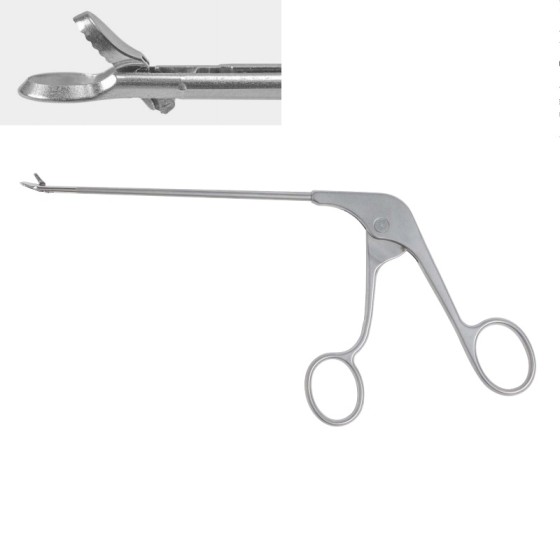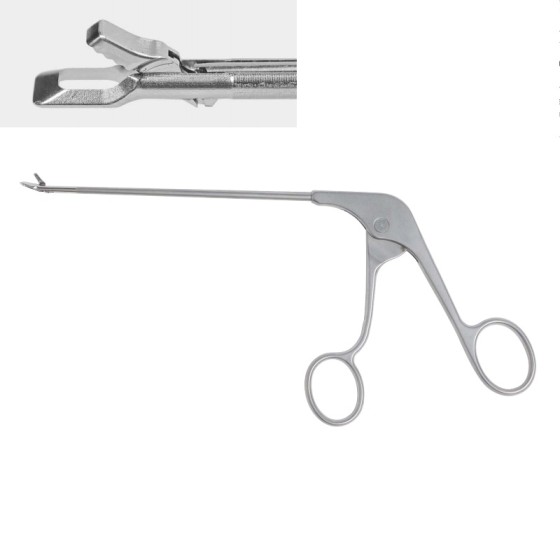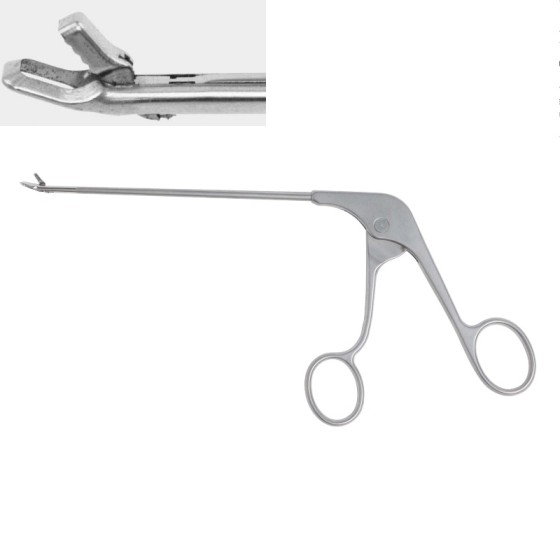Arthroscopic Oval Jaw Punch (Left Curve, Left Direction, Blue Handle) - 4.5mm x 120mm
Based on the description you provided, here is a breakdown of the instrument's features and function.
| Characteristic |
Description |
Notes / Clinical Significance |
| Product Category |
Arthroscopic Punch / Biter |
A cutting instrument used to resect (shave, cut, and remove) soft tissue within a joint. |
| Jaw Design |
Oval Jaw |
The oval-shaped jaw provides a larger biting area, useful for efficient resection of tissue like meniscus or synovium. |
| Jaw Configuration |
Left Curve & Left Direction |
Left Curve: The tip of the instrument is curved towards the left side.
Left Direction (Offset): The jaw is angled to the left relative to the shaft. This combined design allows the surgeon to access and visualize tissue on the left side of the surgical field without awkward manipulation of the scope or instrument. |
| Biting Action |
Punch |
Features a sharp, moving lower jaw that cuts against a fixed upper jaw (or vice-versa), taking "bites" of tissue with each squeeze of the handle. |
| Shaft Specification |
4.5mm x 120mm |
Shaft Diameter: 4.5mm (standard size for many arthroscopic portals).
Working Length: 120mm (the length from the handle to the tip). |
| Handle Type / Color |
Blue Handle |
The blue color is often a manufacturer-specific code, potentially indicating size, type, or part of a product line. It aids in quick identification on the sterile table. |
| Handle Mechanism |
Single-use or Reusable |
Most commonly a reusable instrument with a robust mechanism. |
| Primary Material |
Stainless Steel |
High-quality surgical-grade stainless steel (e.g., 420 or 440 grade) for strength, sharpness, and corrosion resistance. |
| Surface Finish |
Passivation |
A standard chemical process for stainless steel instruments to maximize corrosion resistance. |
| Typical Application |
Arthroscopic Surgery |
Primarily used in knee arthroscopy (e.g., meniscectomy, synovectomy) but also applicable in shoulder, ankle, and other joint procedures. |
🔍 Functional Analysis & Design Advantages
-
Directional Access: The Left Curve + Left Direction design is crucial for accessing specific anatomical areas (e.g., the posterior horn of the medial meniscus in the left knee or specific areas in the shoulder joint). It improves maneuverability and helps avoid "blocking your own view" with the arthroscope. A Right Curve/Right Direction instrument would be used for symmetrical access on the other side.
-
Punch Mechanism: The biting/cutting action allows the surgeon to selectively and precisely remove small pieces of tissue, minimizing the risk of damaging surrounding healthy structures.
-
Oval Jaw: Offers a good balance between bite size and the ability to access tight spaces within the joint.
-
Ergonomics: The handle is designed for a comfortable grip and controlled application of force during repeated squeezing motions.
🏥 Clinical Use Case
This specific instrument is designed for a surgeon operating on the left side of a joint structure. For example:
-
A right-handed surgeon performing a knee arthroscopy would use this Left Curve/Left Punch in their left hand to resect tissue on the medial (inner) side of the left knee, or to reach around structures like the femoral condyle, while viewing with the arthroscope held in the right hand or positioned appropriately.
⚠️ Important Considerations
-
Sterilization: Must be sterilized according to manufacturer's guidelines (typically autoclaving).
-
Handling: Care must be taken not to drop the instrument, as this can damage the precise alignment of the cutting jaws.
-
Inspection: The jaws must be inspected before use for sharpness and any signs of damage or wear. A dull punch can fray tissue instead of cutting it cleanly.
-
Compatibility: The 4.5mm shaft diameter requires a cannula (portal) of compatible size.








